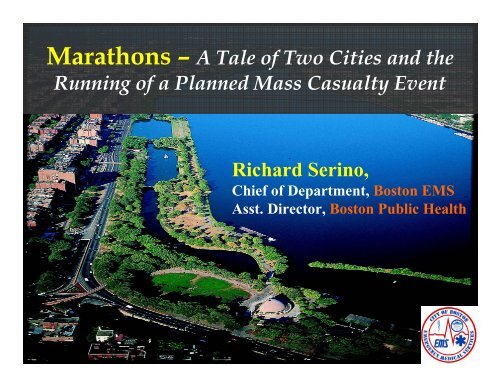url?sa=t&source=web&cd=1&ved=0CCQQFjAA&url=http://www.integratedtrainingsummit.org/presentations/2008/main_training_summit/course_18_-_tale_of_two_cities_and_the_running_of_a_planned_mass_casualty_event_-_serino_richard
url?sa=t&source=web&cd=1&ved=0CCQQFjAA&url=http://www.integratedtrainingsummit.org/presentations/2008/main_training_summit/course_18_-_tale_of_two_cities_and_the_running_of_a_planned_mass_casualty_event_-_serino_richard
url?sa=t&source=web&cd=1&ved=0CCQQFjAA&url=http://www.integratedtrainingsummit.org/presentations/2008/main_training_summit/course_18_-_tale_of_two_cities_and_the_running_of_a_planned_mass_casualty_event_-_serino_richard
You also want an ePaper? Increase the reach of your titles
YUMPU automatically turns print PDFs into web optimized ePapers that Google loves.
Presentation Overview• Planned Disaster Concept• Groundwork• Collaboration•Planning•Execution• Evaluation <strong>and</strong> Analysis
Special Events as Planned DisastersCONCEPT
ConceptSpecial Events: Sharing <strong>the</strong> Characteristics <strong>of</strong> a Major Incident• Special Events (“High Threat Incidents”)– Draw large crowds– Require above normal resource commitments byemergency responders– Special circumstances, such as heat, cold, exertion,substance abuse, <strong>and</strong> o<strong>the</strong>rs present responders withreal (not simulated) opportunities to performinterventions on a large number <strong>of</strong> patients– Frequently result in a high number <strong>of</strong> casualties– Excellent opportunities to exercise disaster, largescale,<strong>and</strong> <strong>mass</strong>-<strong>casualty</strong> incident plans
Special Events asPlanned DisastersGROUNDWORK
Groundwork• Plans must be in place– Communications– Notifications– Operations• Mass-<strong>casualty</strong>• Mass-evacuation• Pharmaceuticals/Prophylaxis Distribution• Fire suppression• O<strong>the</strong>r consequencemanagement• Partnerships need to bedeveloped
Special Events as Planned DisastersCOLLABORATION
Collaboration• During an actualmajor incident, no oneagency works alone• Agencies have uniqueresponsibilities• Agencies must knowhow cooperatingagencies will respond
CollaborationWorking Toge<strong>the</strong>rUtilize special <strong>event</strong>s <strong>and</strong> drills asopportunities to plan & train toge<strong>the</strong>r sothat you may institutionalize ‘workingtoge<strong>the</strong>r’.People <strong>and</strong> agencies will fall back on what <strong>the</strong>y knowduring emergencies. Through building necessaryactions <strong>and</strong> protocols into regular operations, webecome better prepared.
CollaborationUnified Comm<strong>and</strong>• Jurisdictions talkabout unifiedcomm<strong>and</strong> <strong>of</strong>ten• Plan to implementa unified comm<strong>and</strong>structure for your<strong>planned</strong> disaster• Consider opening aunified comm<strong>and</strong>center
CollaborationWorking with <strong>the</strong> MediaTheir mission is to get a story. Building alongst<strong>and</strong>ing relationship with journalists<strong>and</strong> reportersensures that<strong>the</strong>y get <strong>the</strong>right story <strong>and</strong>that <strong>the</strong>y serveas a resourcewhen needed.
Special Events asPlanned DisastersPLANNING
Planning•Interface <strong>and</strong>integrate with <strong>the</strong><strong>event</strong> <strong>org</strong>anizers• Bring <strong>the</strong> right peopleto <strong>the</strong> table• Develop a mission• Develop specific <strong>and</strong>measurable objectives• Decide <strong>the</strong> elements<strong>of</strong> your plan you wantto focus on exercising•Determine whatpartners you want toinclude in yourexercise• Be ambitious, but berealistic
PlanningAssess Potential Threats• Determine what could go wrong <strong>and</strong> wha<strong>two</strong>uld be done to minimize risk, injury,<strong>and</strong>/or damage.• Ex: How would you shelter marathonrunners if <strong>the</strong>re was a hurricane?
PlanningSpecial Operations
Boston EMS – Tango Trucks (3)•Tyvek Suits•Backboards•Stretchers• Defibrillator• Ladder•Blocks•O2 Tanks• Multilators•Mark 1•etc….
Boston EMS – Gators & Golf Carts
Boston EMS - Bicycles
PlanningIncident Comm<strong>and</strong>Incident Comm<strong>and</strong> System (ICS)– Incident Comm<strong>and</strong>er– Comm<strong>and</strong> staff– General staff– Appropriate branches– Pre-designated task forces– De-escalation– Call sign usageUnified Comm<strong>and</strong>– Develop structure in advance– Explain <strong>the</strong> concept– Build relationships withcooperating agencies
PlanningCommunications• Interoperable communication acrossagencies & jurisdictions• Consider a tactical frequency• Dedicate a dispatcher for large<strong>event</strong>s•Utilize earpieces
PlanningAccess <strong>and</strong> Egress• Cordon-<strong>of</strong>f evacuationroutes around congestedareas• Make use <strong>of</strong> aerial views forplanning• Escalate resourcecommitments around busy<strong>event</strong> periods
PlanningEvent Escalation• Assign personnel to busy areas but bearaccess <strong>and</strong> egress in mind• De-mobilize resources as <strong>the</strong> <strong>event</strong> deescalates• If <strong>the</strong>re is a <strong>mass</strong> exodus, considerimpact units around heavy exoduszones• Delicate balance: <strong>main</strong>taining citywidecoverage during major <strong>event</strong>s• “Life goes on…” while “everyone” is at<strong>the</strong> <strong>event</strong>
EXECUTIONSpecial Events as Planned Disasters
Execution• Proactive action (for heat orcold)– Mount a coordinated riskcommunication campaignusing media outlets before<strong>and</strong> during <strong>the</strong> <strong>event</strong>– Encourage runners &revelers to wearsunscreen, stay hydrated,etc.– Develop hot-wea<strong>the</strong>rsafety tips pocket cards<strong>and</strong> magnets
Execution• Incident Action Pl<strong>and</strong>eveloped in advance• Mobilization details, demobilizationdetails• Coverage assignments• ICS call signs, grid maplocations, contingencyplans, pertinentappendices• BEMA <strong>and</strong> BFoJ or BAAcoordinate inter-agencyplanning
Mapping• Scaled maps for <strong>the</strong><strong>event</strong>, specialized fora specific purpose–Improved upon eachyear• All maps are based onconsistent gridcoordinates– Makes dispatchingsimple <strong>and</strong> efficient– Zone designations forincident reporting
MappingBoston Marathon
Mapping Boston Marathon
Medical Response• Much <strong>of</strong> <strong>the</strong> care renderedis <strong>the</strong> result <strong>of</strong> patients selfdeliveringto medical tents• Large crowds presentaccess issues for rapidresponses for patients thatcannot self-deliver• Solution: Proceed Out <strong>and</strong>Rapid Response Teams– Gators– Bicycles– Fully staffed <strong>and</strong> equippedmedical tents
Medical Response• All tents can functionnear <strong>the</strong> capacity <strong>of</strong> anemergency room– Assorted medical supplies– Pharmaceuticals– Defibrillators– Re-hydration solution– Disaster supplies• Physicians present atmedical tents for closemedical oversight <strong>and</strong>critical patients• WMD CST <strong>and</strong> BFDpartnered with forHazMat/MCIdecontamination
Medical ResponsePatient Tracking• Using MMRS & UASI funding,Boston EMS has developed aPatient Tracking System for <strong>the</strong>Metro Boston Region.• Patients tracked with uniquebarcodes on a web based system.– Location , status & unique ID arerequired fields.– Registered runners are preloaded in<strong>the</strong> system• Special Events have been utilizedto trial <strong>and</strong> evaluate <strong>the</strong> system.
CredentialingFor all Exercises & Special Events• All personnel pre-screened• All personnel must gothrough credentialingprocess• All personnel (evenuniformed) must displaycredential at all times
Transferable Lessons•Boston Marathon<strong>of</strong>ficials observeBoston Fourth <strong>of</strong> Julyoperations (vice-versa)•Over <strong>the</strong> years,lessons have beenlearned on both sidesas to how to enhanceoperations safety
Logistics Needs• Food, ice, <strong>and</strong> waterwill all be neededduring a majorincident – special<strong>event</strong>s are no different• Distribution can betricky, given all <strong>of</strong> <strong>the</strong>personnel to feed• EMS cordons <strong>of</strong>f ourown logistics center
Special Events as Planned DisastersEVALUATION ANDANALYSIS
Evaluation <strong>and</strong> AnalysisAfter every major special <strong>event</strong> or incident,<strong>the</strong>re are formal <strong>and</strong> informal discussionsevaluating <strong>the</strong> response, what went well<strong>and</strong> areas for improvement.
Evaluation <strong>and</strong> Analysis• Each year is a learningexperience• Essential to takelessons learned from<strong>the</strong> <strong>planned</strong> disaster<strong>and</strong> integrate <strong>the</strong>minto operationalplanning• Analysis should beongoing• After-action reportsare essential toeffectively capture <strong>the</strong>successes <strong>and</strong> failures• Develop action items
Evaluation <strong>and</strong> AnalysisDue to <strong>the</strong> inherent similarity between <strong>the</strong> medicalresponse for special <strong>event</strong>s <strong>and</strong> disasters, wehave seen a continual improvement in ouremergency response capabilities as we preparefor <strong>and</strong> execute plans for special <strong>event</strong>s.For that reason, we consider any weakness in ourresponse to a special <strong>event</strong> to be a weakness inour emergency preparedness capabilities, taking<strong>the</strong> utmost care to address such issues as soon aspossible.
Thank YouRichard SerinoChief, Boston EMS617-343-2367<strong>serino</strong>@bostonems.<strong>org</strong>


